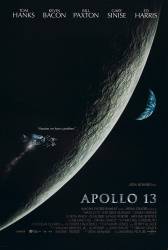Revealing mistake: In the final 1/2 hour there's a scene in which Kevin Bacon is drifting weightlessly in the lunar module, with a roll of duct tape floating nearby. Just during the last couple of seconds of this shot, suddenly he & the roll accelerate to the right. As everyone now knows the zero-g scenes were photographed on-board an aircraft which flies free-fall arcs for up to about 20 seconds before having to level off. The sudden acceleration on the set means that shot was filmed just as the plane was leveling off from a dive. (01:53:40)

Apollo 13 (1995)
1 revealing mistake - chronological order
Directed by: Ron Howard
Starring: Tom Hanks, Ed Harris, Kevin Bacon, Bill Paxton, Gary Sinise
Factual error: Moments before and during the lift-off of the Saturn V, Ken Mattingly is shown to be watching from a somewhat private grassy field. Wherever he is supposed to be, he is far too close to the launch pad. No unauthorized persons were allowed to be that close, and certainly not in an undisclosed and unsupervised area, not the least of which was for security reasons. The fact that Mattingly is an astronaut would not give him carte blanch to do this, and his training and discipline would prevent his ever attempting doing so in the first place. In reality, Mattingly was in Houston at Mission Control at the time. Otherwise it is a nice shot.
Gene Kranz: I don't care about what anything was *designed* to do. I care about what it *can* do.
Trivia: The exchange between Lovell and his wife about holidays ("you know that Easter vacation? There's been a change of destination ... how about the moon?") in fact took place in 1968, when Lovell was assigned to Apollo 8 and so missed his planned Christmas vacation.





Answer: From what I have read, according to the real astronauts, it was not as cold in the capsule as was depicted in the film. The movie exaggerated that for dramatic effect.
raywest ★